Fansipan summit complex features spiritual and cultural structures such as temples and statues, offering visitors a blend of natural beauty and cultural enrichment in Vietnam. SIXT.VN can help you plan your trip to Fansipan, offering convenient transportation and travel advice. Discover Fansipan cultural attractions, Sapa Vietnam tourism, and Indochina’s highest peak seamlessly.
1. Guide: Climbing Mt. Fansipan
There are several trails to reach the summit of Mount Fansipan, known romantically as the ‘Roof of Indochina.’ However, only one is easy enough (and safe enough) to follow independently, without a guide. This is the trail that begins at the entrance to Thác Tình Yêu (Love Waterfall), 15km west of Sapa on road QL4D. Known as the Tram Ton Pass trail, it’s fairly easy to follow and, despite local opinions to the contrary, can comfortably be climbed in one day, without a guide. However, it’s still essential to prepare and climb responsibly and safely. In this guide, I’ve tried to include as much information as I can so that other climbers who want to make the ascent independently may do so. However, please note that although all the information in this guide is accurate at the time of writing, I can’t guarantee that things won’t change in the near future.
Selected Resources What’s this?
2. Time, Distance & Duration: How Long Does it Take to Reach Fansipan’s Peak?
According to the signs at the trailhead, the one-way trek from the starting point of the Tram Ton Pass trail (at the entrance to Love Waterfall) to the summit of Mount Fansipan is 11.2km. We made the ascent in 6 to 6.5 hours. We climbed at a leisurely pace with regular short breaks, either to rest or to hydrate and have a snack, or to take photos and admire the views. We left our hotel in Sapa at a reasonable hour in the morning, after breakfast, sometime around 7.30am. The taxi ride to the trailhead takes 10-20 minutes, so we were on the trail by roughly 8.00am. We reached the summit after lunchtime, approximately 2.15pm. You could potentially make the ascent in under 6 hours if you’re very fit, don’t stop often, and have perfect trekking conditions. However, I would imagine that for most people of average fitness who simply want to successfully scale the highest mountain in Indochina and enjoy the walk, the views, and the experience (rather than treat it as an athletic contest), a general estimation would be anywhere from 6-9 hours. But there are other factors to consider: weather conditions might slow you down; perhaps you will get cramp and need an extended rest; maybe part of the trail is obstructed by a large branch or landslide. This is why you should leave fairly early in the morning, so that even if you encounter any unforeseen circumstances, you will still have time to reach the summit before nightfall. Note that, if you do run out of daylight hours, there are two permanent camps along the trail to the summit, one at 2,200m, the other at 2,800m.
3. What Level of Fitness Is Needed to Climb Fansipan?
Climbing Mount Fansipan in one day via the Tram Ton Pass trail is something that most people in reasonably good shape can do. However, it does require a significant physical effort and, because of the altitude, breathing difficulties caused by lack of oxygen make the climb even more of a challenge. When I made the ascent I was 34 years old and in pretty good physical condition. I was with my dad and uncle, who were 73 and 69 respectively, both of whom take daily exercise in the form of long-distance swimming and running. I found the ascent challenging but by no means exhausting. However, I do take regular, strenuous exercise. I also think that my concern for my dad and uncle’s physical well-being on the trek kept me focused on their efforts rather than my own. My dad and uncle both made the ascent without incident, but they both agreed it was one of the toughest physical pursuits they can remember undertaking. We encountered around a dozen other climbers on the trail (all with guides), most of whom were younger than us and had taken two days for the ascent, spending one night at one of the base camps. However, the other climbers appeared to be mostly of average fitness and had not had any trouble making the ascent. They seemed to be in good spirits and while they had found the climb challenging, they were not exhausted. The first half of the trail is well-marked and of moderate steepness, but the second half is rocky and very steep at times, involving metal ladder and peg-ladder climbs. Particularly grueling is the last couple of hours, when several steep ascents immediately descend again, which can be very demoralizing, especially as the air is getting thinner and your body more tired.
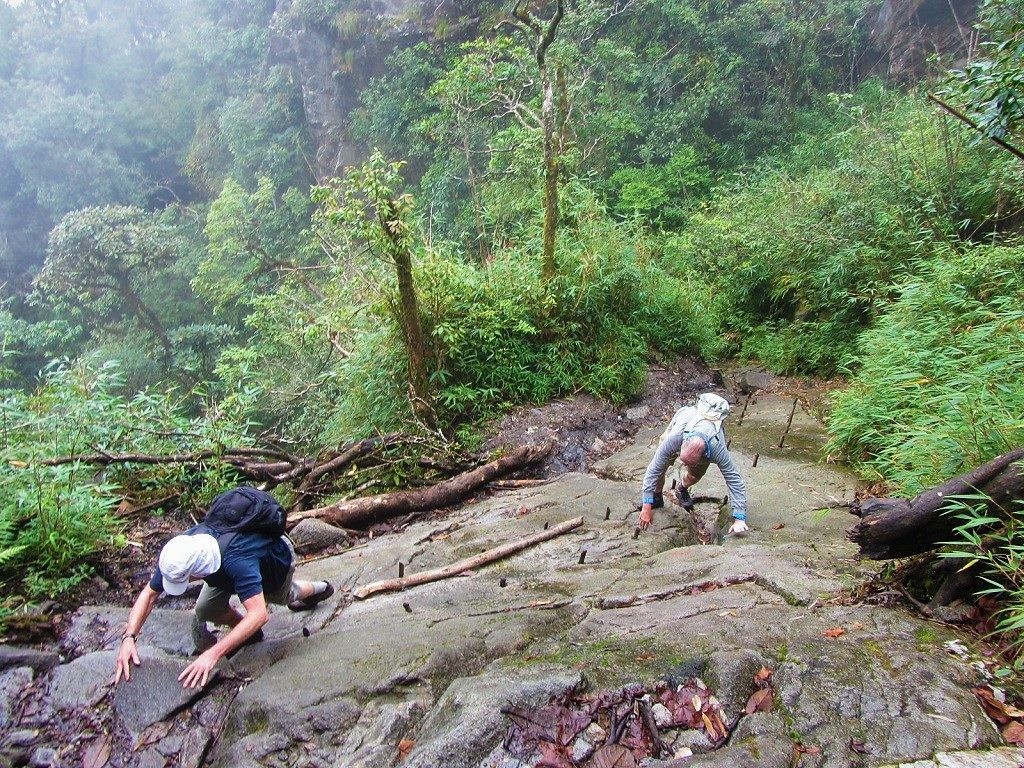 Climbing Fanispan mountain independently, without a guide, Vietnam
Climbing Fanispan mountain independently, without a guide, Vietnam
4. What Supplies and Equipment Should I Bring for the Fansipan Climb?
Although you don’t need any specialist equipment to climb Mount Fansipan, you still need to carefully consider what to wear for the trek and what to bring with you. The unpredictable mountain weather means that conditions can be very hot and very cold on the same day. In general, temperatures around Mount Fansipan and Sapa are significantly cooler than lowland Vietnam. Daytime temperatures can be mild to warm (15-25°C) during the summer months, or cool to cold (5-10°C) during the winter. On the summit it can reach freezing, and the added wind chill factor can make it feel even colder. However, the physical exertion of the climb will make you feel stuffy and hot. Therefore, it’s best to dress in light but warm and windproof clothing, with the option to strip off one layer if you get too hot. For example, we wore a T-shirt, sweater, and thin waterproof at the beginning of the climb, when the morning temperatures were cool and our bodies had not warmed up. During the middle of the trek, with the difficulty and temperature increasing, we stripped off a layer. But as the clouds descended, the wind picked up, and a light rain began to fall near the summit, we re-clothed for full protection.
 Climbing Fanispan mountain independently, without a guide, Vietnam
Climbing Fanispan mountain independently, without a guide, Vietnam
For footwear, standard hiking shoes are perfect, but decent trainers are also fine. I made the climb in my Adidas Barricade tennis shoes, which are fairly hardy trainers. (Many of the guides we met were wearing flip-flops for the climb, and the Vietnamese young women in their group were wearing plastic bags over their shoes to keep them dry and clean, which would also make them treacherously slick.)
Take a small backpack with some food and drink supplies, and remember to leave room for your clothes for when you get too hot. There are no shops or kiosks on the trail, although you could potentially stop at one of the two camps if you needed to. The most important thing to bring is water, lots of it. Dehydration leads to cramp and that can be extremely dangerous on a mountain. We took three litres of water each (two 1.5 litre bottles in each of our backpacks). For food, we stocked up on local milk candy bars (bánh sữa) and Vietnamese energy bars, called lương khô, which are like army rations: compact and full of energy. At the summit there are all sorts of dining and drinking options, so you can look forward to a hot coffee and a burger when you get to the top. My dad took his trekking poles which he’d brought with him from the U.K, but you might be able to find them in the stores in Sapa somewhere, too.
 Climbing Fanispan mountain independently, without a guide, Vietnam
Climbing Fanispan mountain independently, without a guide, Vietnam
5. Is It Safe to Climb Fansipan Without Permission?
Although Mount Fansipan can be climbed independently, without requiring any specialist equipment, climbing abilities, or permission, it is still vital that you treat the ascent seriously by preparing sensibly and climbing responsibly. There have been deaths on the mountain in recent years, including foreign tourists attempting the ascent without a guide. Like any high mountain, Fansipan can be dangerous, and the risks of climbing alone, without a guide, should not be underestimated.
The trail is well-marked for most of the ascent and is fairly easy to follow. However, when the clouds descend on the mountain, visibility can be very bad, leading to difficulty finding your way. In damp conditions, the rocks can become very slippery. Tread carefully because even a minor slip can lead to an injury, and even something as small as a sprained ankle can cause big problems when on a cold, wet mountainside with no help. It should go without saying that straying from the trail, or climbing boulders and cliff faces without proper equipment, is an extremely bad idea.
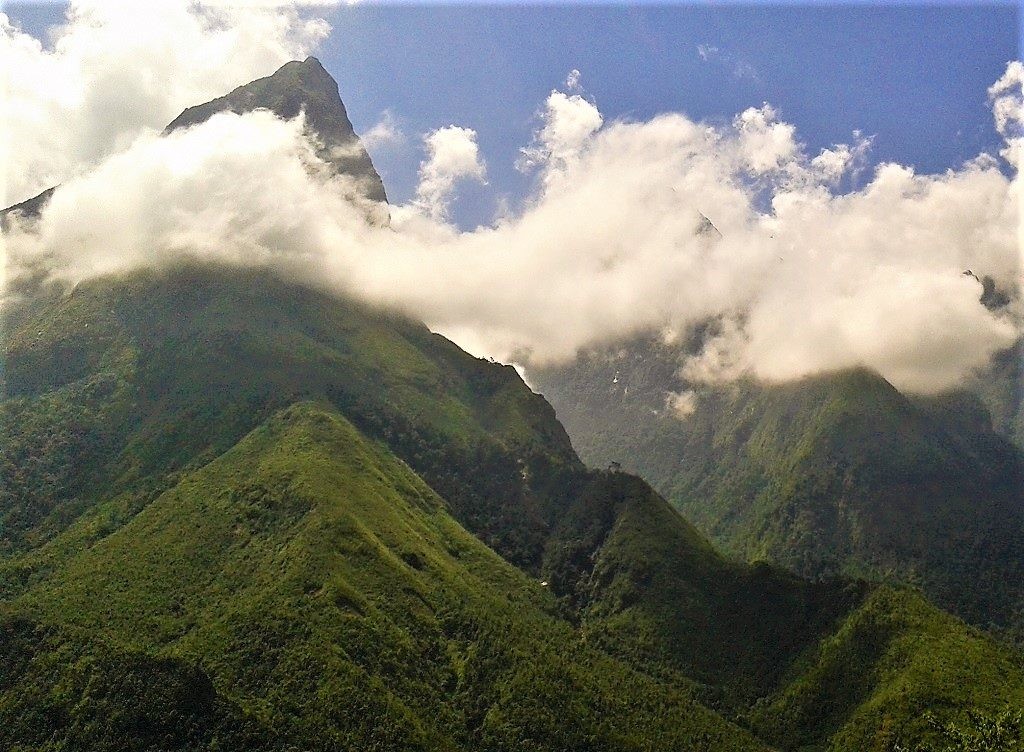 Fansipan mountain, Vietnam
Fansipan mountain, Vietnam
It’s essential to stay hydrated. Bring lots of water with you. The climb is strenuous so you will be perspiring all the time, even if it doesn’t feel like it because of the cool weather conditions. Dehydration leads to cramp, which can be a major hindrance, forcing you to stay static for hours at a time. Cramp may not sound serious, but if your legs cramp at 10,000ft as a storm is blowing in and the daylight is fading, your situation can suddenly become very grave. Make sure you bring some warm clothing. The mountain can get very cold, even in the summer months. If you get stuck on the mountain in freezing temperatures, hypothermia is a serious possibility.
If possible, don’t climb alone. Go with a companion or a small group. If something happens to one of you, the other can get help. Bring your mobile phone. There’s a phone signal for most of the ascent. Make sure you have a local SIM card with plenty of credit. It’s best to get a Viettel SIM, because they tend to have the widest coverage in the mountains. Make sure your battery is fully charged, or even better, bring a USB battery pack so you can recharge your phone on the climb. Take a small flashlight in case it gets dark.
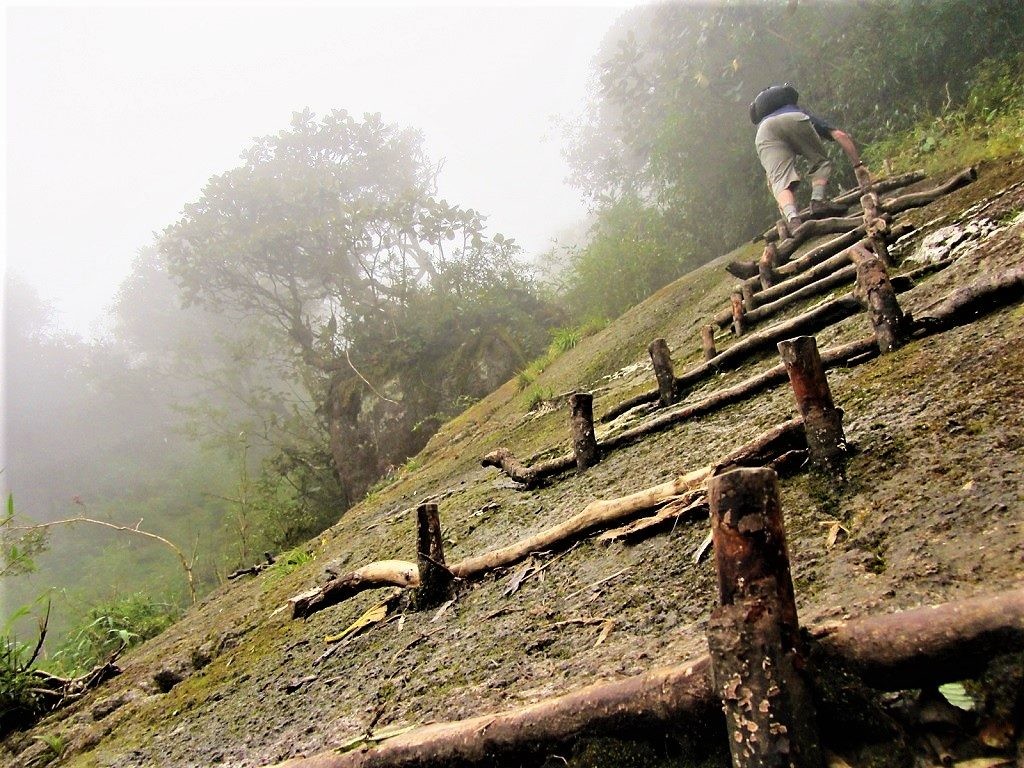 Climb Fansipan mountain independently, without a guide, Vietnam
Climb Fansipan mountain independently, without a guide, Vietnam
When it comes to permission, before the ascent I’d read all sorts of stories about independent climbers not being allowed on the mountain, being turned back or even fined by national park authorities. In reality, however, we didn’t encounter any authorities on the climb, no tickets or permission papers were asked for, and none of the official guides we passed and spoke with mentioned anything at all about it. No doubt, one of the reasons the authorities and tourist agencies in Sapa say it’s not possible to climb Fansipan independently is because, if such a climber were to have an accident, it would not only be a personal tragedy, it would give the mountain and the national park bad press and a bad name. This seems reasonable to me. However, part of discouraging independent climbers is also likely to do with money. A guided climb can cost upwards of $100. And yet, we met a number of guides and their groups who didn’t appear to have safety in mind: they were climbing with flip-flops or, in some cases, with plastic bags over their shoes so as not to get them wet or dirty, thus increasing the chances of a nasty slip or fall because of the lack of traction. Unless things have changed by the time you read this, it certainly is possible to climb Fansipan independently, without a guide and without needing to get permission. However, if you do climb independently, have some respect for the mountain and for the independent climbers who will follow in your footsteps: don’t be reckless; climb responsibly and safely. If your negligence leads to an accident on the mountain, you give other independent climbers a bad name, and the authorities the perfect excuse to ban independent climbers in the future.
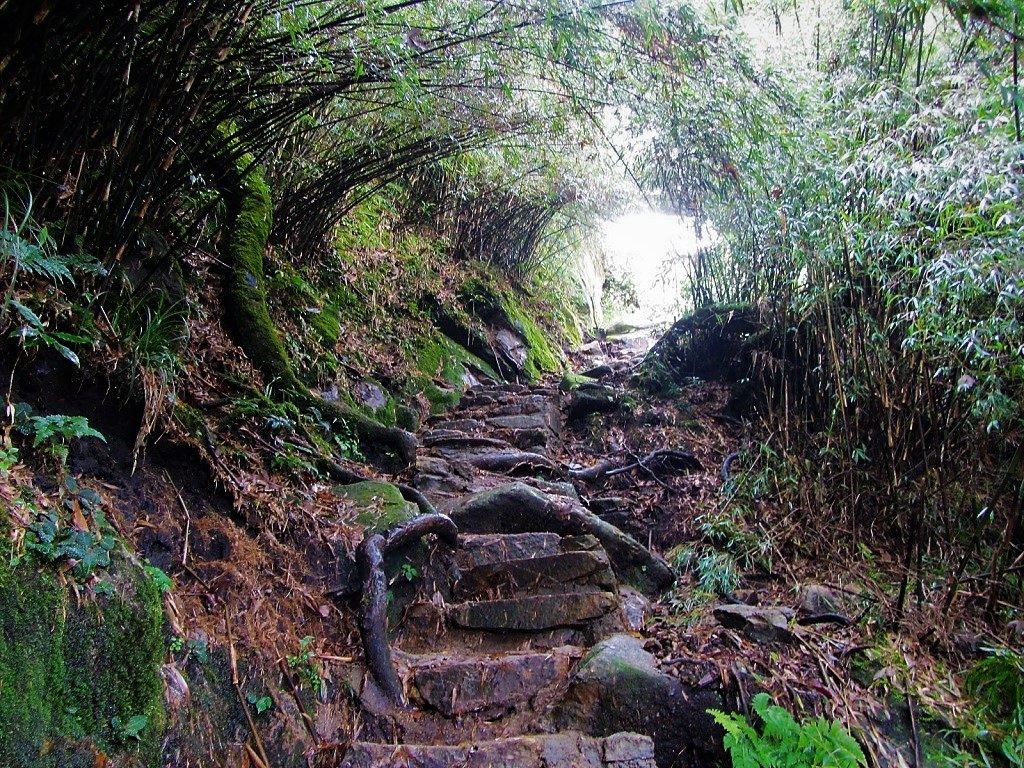 The hiking rail up Fansipan mountain, Vietnam
The hiking rail up Fansipan mountain, Vietnam
6. When is the Best Time to Climb Fansipan and What Weather to Expect?
As with most high mountains, weather on Fansipan is very unpredictable and subject to change within minutes all year round. In the morning, the summit might be perfectly visible from Sapa, gleaming in the fresh highland light; but by the time you reach the trailhead, just 15 minutes later, thick cloud might have descended on the lower slopes, and a drifting rain set in above the forests. Likewise, the temperatures fluctuate from hour to hour. Perhaps hiking through the dense forests on the lower slopes, humidity and heat will force you to strip off your layers; but as soon as you emerge from the foliage onto an exposed, treeless ridge, the wind ripping in from the north, you’ll be chilled to the bone and reaching for your jacket. Most people agree that the best times of year for climbing Fansipan are spring (March, April) and autumn (September, October). During these months there’s a good chance that the sun will shine for at least some portions of the climb and temperatures are fairly mild. On our climb, for example, we had beautiful weather in the morning, but the higher we ascended the more the weather closed in, and for the last third of the climb we could hardly see 10 metres ahead of us, including at the summit.
 Misty, cloudy weather over Fansipan mountain, Vietnam
Misty, cloudy weather over Fansipan mountain, Vietnam
7. How Do I Get to the Fansipan Trailhead?
Sapa is the base from which to plan and start your ascent of Mount Fansipan. From the hotels, hostels and homestays in and around Sapa, it’s a 10-20 minute journey by taxi to the trailhead at the top of the Tram Ton Pass (also known as O Quy Ho Pass). Ask your taxi to take you to Thác Tình Yêu (Love Waterfall), which is 15km west of Sapa on road QL4D. The car park and entrance to Love Waterfall is on your left (if you’re approaching from Sapa) just at the top of a mountain pass, which is in turn the beginning of the Tram Ton Pass, wiggling its way around the mountains to the west of Love Waterfall. By the roadside opposite the entrance to Love Waterfall, a large billboard titled ‘Hoang Lien Son National Park’ has a rudimentary map of the three trails leading to the summit of Mount Fansipan, including the camp sites. The one that begins at Love Waterfall (the Tram Ton Pass trail) is the furthest to the right on this map. However, there’s very little detail. From the car park at Love Waterfall, walk under the entrance arch (with the words ‘Suối Vàng-Thác Tình Yêu’) and bear left, opposite the ticket kiosk for the waterfall. There’s a little noticeboard titled ‘Rules for Conquering Fansipan Summit’, at the bottom of which is a casual arrow announcing ‘Fansipan Summit 11.2km’. (Note: when we made the ascent, there was no one at the entrance, or anywhere else for that matter, who asked us to buy tickets for the trail.)
A taxi is the easiest way to get to the trailhead at Love Waterfall. There are lots of taxis in Sapa and the fare is only around $10 (200,000vnd). However, you could also arrange a motorbike taxi from Sapa (which would be cheaper), or a minivan (if there’s a group of you) which can be arranged through your hotel, or even self-drive there on a rented motorbike, but then, of course, you’d have to return to the trailhead after the climb in order to pick up your bike again. SIXT.VN offers convenient and reliable transportation options, including taxi and minivan services, to get you to the trailhead comfortably.
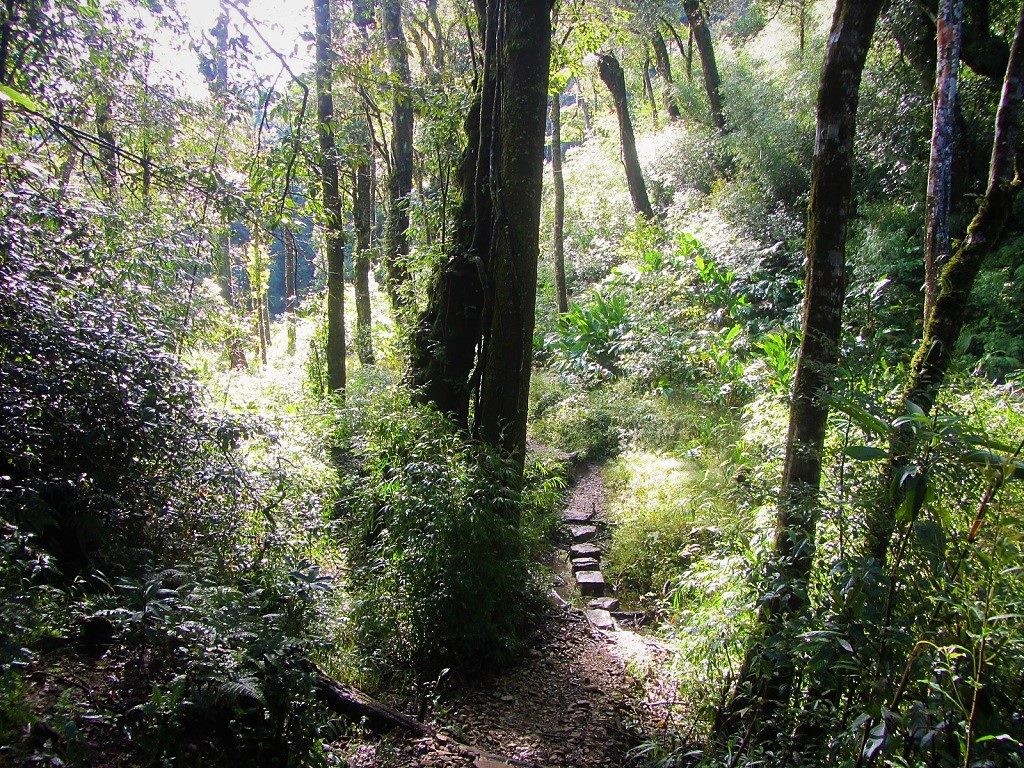 The hiking trail up Fansipan mountain, Vietnam
The hiking trail up Fansipan mountain, Vietnam
8. What is the Experience of the Fansipan Climb & Ascent?
From the trailhead, the pathway immediately plunges into brush and forest. The trail is good: paved at first, with large stepping stones over cold mountain streams. Some of the trees, bushes and flowers are labeled. The canopy is thick but light shines through the branches, illuminating patches of the forest floor, thick with roots and fallen leaves. The first hour or so is peaceful, quiet, gentle and pretty – it reminded me of walking in the Welsh landscape on a damp but bright spring day.
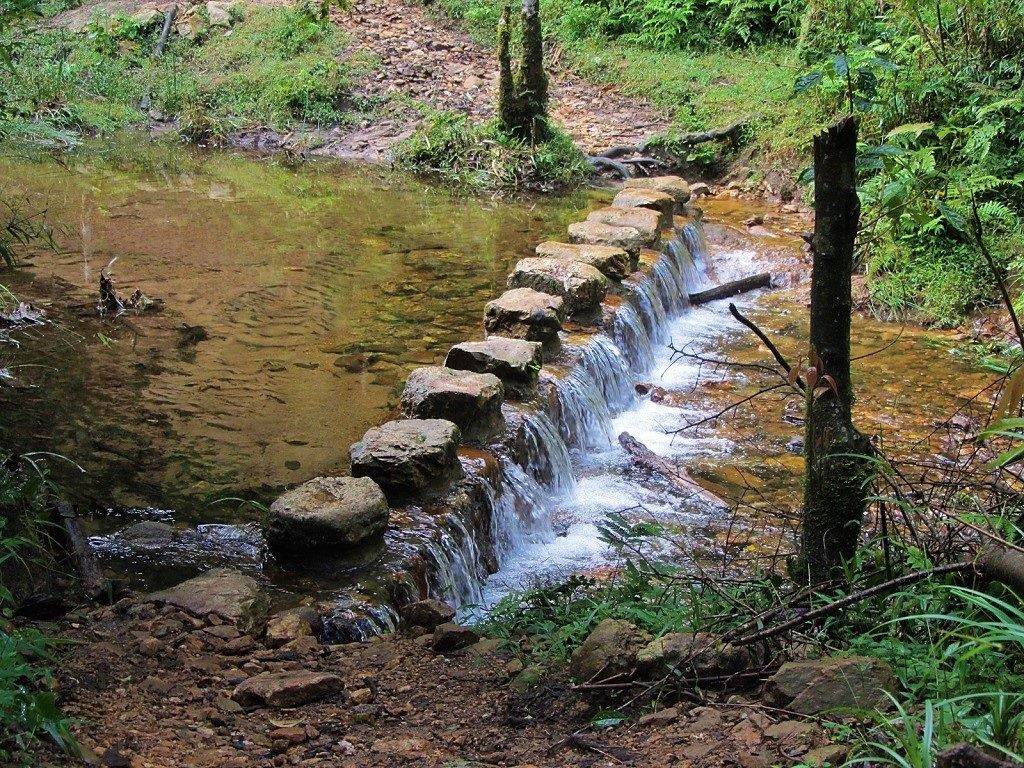 The hiking trail up Fansipan mountain, Vietnam
The hiking trail up Fansipan mountain, Vietnam
The Tram Ton Pass trail to the Fansipan summit is undulating: it rises steeply and then falls. This can be dispiriting, because each time you expend effort to ascend a steep section, the pathway immediately descends half the height you just gained. Thus, it feels like two steps forward, one step back. A couple of hours into the climb, the forest gradually fades: going from a thick, gnarly canopy, to a spindly, thin covering with bald patches, until it disappears altogether, leaving you hiking along the top of an exposed ridge. Although open to the elements, the views back over the forested valleys and mountains are wonderful.
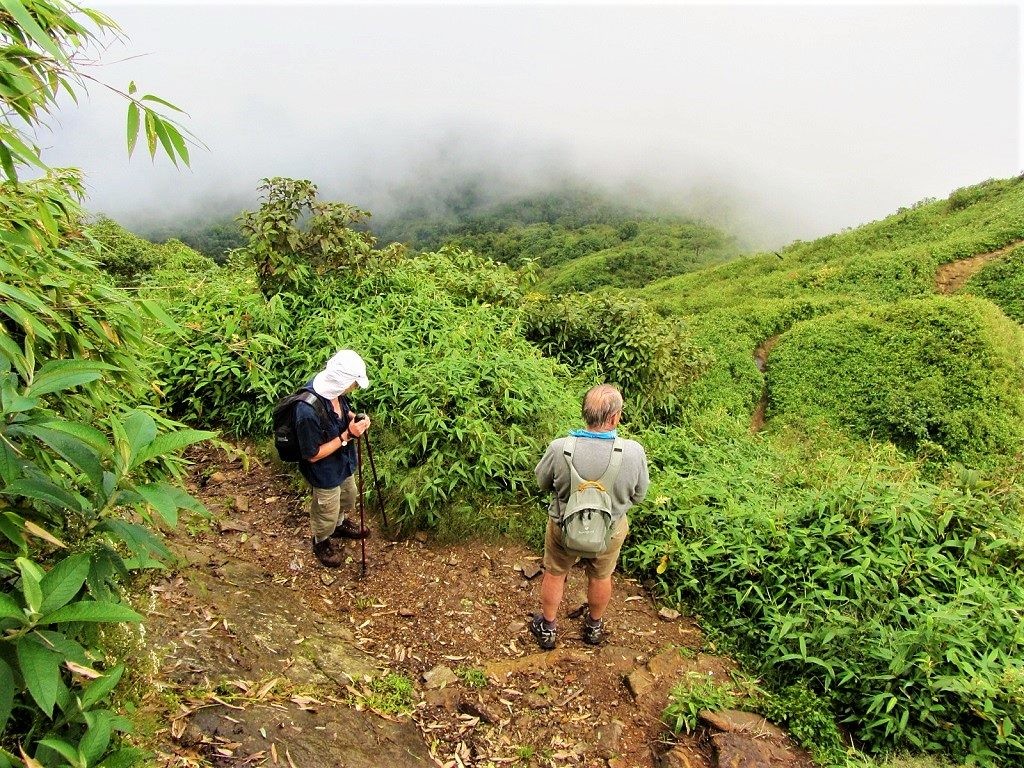 Climbing Fansipan mountain independently, without a guide, Vietnam
Climbing Fansipan mountain independently, without a guide, Vietnam
The middle section of the climb involves increasingly steep hikes along a clearly marked but deteriorating dirt trail. From the first campsite at 2,200m (there are two on the climb, both of which consist of corrugated iron roofed huts), the going gets tougher. The trail is steep, slippery and rutted; grooved by rivulets of rain water running down the mountainside. The air gets thinner, breathing becomes more difficult, the wind picks up and the temperature plummets. There are expansive views east over Sapa and west over Lai Chau, but during our ascent this was when the clouds drew a curtain of grey over the mountain, and although we could feel the gaping landscapes below us, we couldn’t see much at all.
 Climbing Fansipan mountain independently, without a guide, Vietnam
Climbing Fansipan mountain independently, without a guide, Vietnam
Before reaching the second campsite (at 2,800m), there are a couple of major ascents which climb in altitude very rapidly. Parts of this section are so steep and rocky that metal rails, fixed ladders, and peg-ladders have been installed to help climbers get up. These can be quite tricky, especially if it’s wet. There are a few big and dangerous drops close to the ladders, so it’s essential to climb cautiously. This is also the point at which, if you suffer from vertigo, the steep slopes, sharp drops, and sensation of being very high up may start to affect you. A variety of bamboo grows on the mountainside here, known as ‘Dwarf Bamboo’. As the named suggests, it’s short and stocky but has delicate leaves and stems, unlike the large, towering clumps of bamboo you get in lowland Vietnam. Also, several kinds of rhododendron bushes that like high altitude are scattered around the trail, their pink, purple and violet flowers brightening the grey weather conditions.
 Wild flowers on Fansipan mountain, Vietnam
Wild flowers on Fansipan mountain, Vietnam
The last climb, from the second campsite to the summit, is tough. It starts out gentle, and then descends. You pay for this later when the gradient gets very steep, including a peg-ladder up a sheer rock face. There’s a dramatic moment when a giant escarpment reveals itself, plunging down into the cloudy abyss below. For me, this was the first time on the climb that I had the sensation of being near the peak of a big mountain. It suddenly struck me that we were now higher than any other natural formation in this southeastern corner of the Asian continent. Strangely, this was also the moment when we heard, and then saw, the cable car emerging from the mist above us. Then came the sound of clanking hammers working on the construction site that sprawls around the peak. In fact, there was plenty of construction debris strewn around the trail as we got nearer the summit, presumably discarded from the building site. This made us think we were near the top, but the climb dragged on, winding around the various developments: pagodas, a giant seated Buddha, restaurants, viewing platforms, shops. When we finally reached the grand, wide staircases leading to the summit, the weather had closed in to the point that the pylons marking the peak were hardly visible. We weren’t rewarded with fine views over the Hoang Lien Son Mountain Range, but I’m sure they are absolutely spectacular in clear weather. However, this didn’t take anything away from our own sense of achievement at having made the climb and enjoyed it.
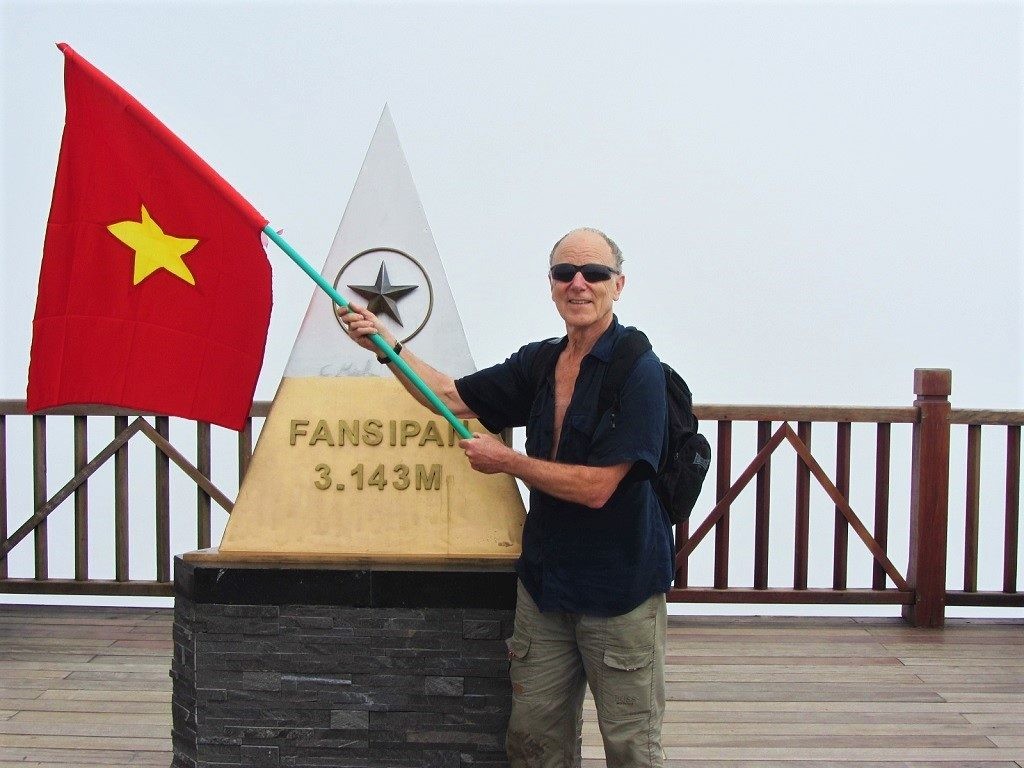 Fanispan mountain summit, Vietnam
Fanispan mountain summit, Vietnam
9. What Can You Expect at the Fansipan Summit?
Only a few years ago, the summit of Mt. Fansipan was what mountain peaks should be: wild, windswept, and isolated; just you are your fellow climbers standing alone, seemingly on top of the world, with nothing but nature surrounding you. And all this was gained through your own physical effort; the views over endless ridges and peaks poking above the clouds your reward for the climb. These days, however, things are very different indeed. In 2016, a cable car to the summit of Fansipan opened, thus transforming the ‘Roof of Indochina’ forever. After climbing for over 6 hours through forests, along streams, over giant, moss-fleeced boulders, and into the clouds without encountering more than a dozen people along the way, it comes as quite a shock when, within sight of the summit, the silence is broken by the purr of the cable car, the clank-clank of construction work, the nasal tones of announcements over public address systems, and the silhouettes in the mist of what appears to be a city in the sky. This is the reality of Fanispan’s summit today: a commercial toy town of fast food stands, souvenir shops, photography booths, tourist transportation systems, grand staircases, wooden decks and plank walkways, Vietnamese flags, summit pylons, and a sprawling Buddhist temple complex, including a giant seated Buddha presiding over the scene.
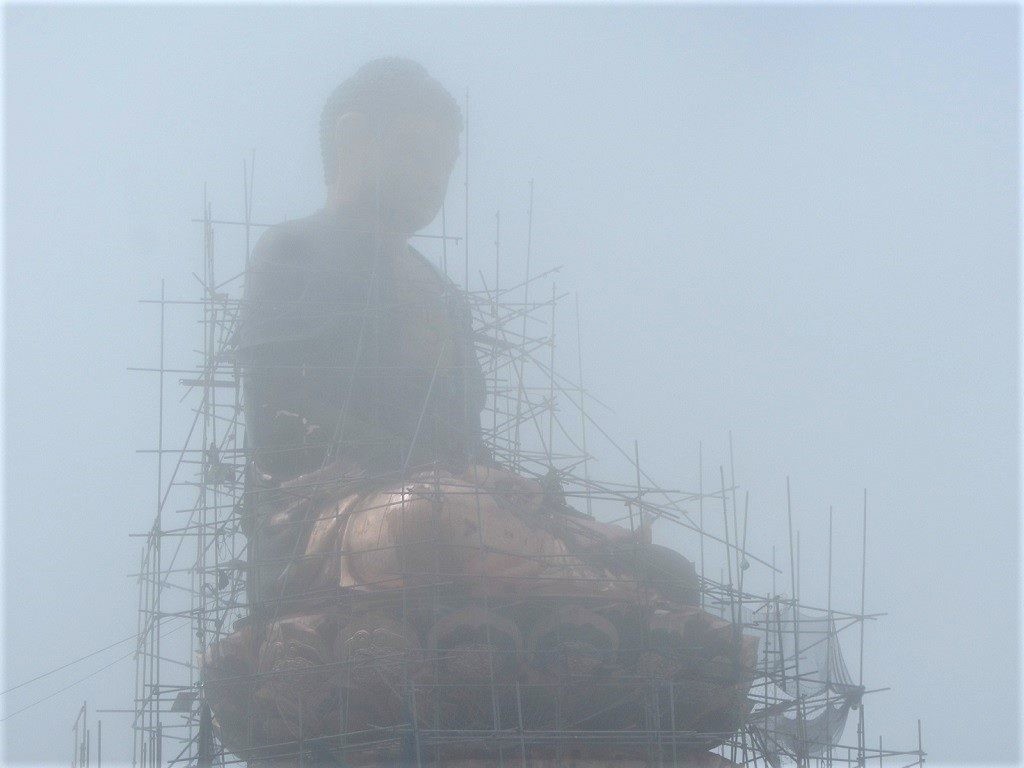 Statue of seated Buddha, Fansipan mountain summit, Vietnam
Statue of seated Buddha, Fansipan mountain summit, Vietnam
It’s jarring, impressive, unsettling, convenient, and confusing. In the thin air, hungry and tired after the climb, I felt a kind of culture shock on arriving at this fairground of a mountaintop. We were grateful for the hot food at the restaurant and the good, strong, hot coffee, and we gladly grabbed the Vietnamese flags, provided at the summit, and waved them above our heads next to the pylons. And we were relieved at the attractive (too attractive to resist) option of taking the cable car down the mountain, back to Sapa. We would have enjoyed the views, too, were it not for a thick fog. To some extent, at least, the structures built on and around the summit are in fairly good taste and make an impressive visual impact. The imperial-style gates that appear to lead into a kingdom beyond the clouds for example, or the mysterious silhouette of the giant Buddha waxing and waning in the mist, seemingly levitating above the material world. It was odd to see the crowds of people there, most of whom were dressed in their best, shiniest winter clothes so as to look good in all the portraits they were having taken at the summit. For Vietnamese, it’s becoming a national pilgrimage to take the cable car to the top of Fansipan, the highest point of their nation. We saw octogenarians and toddlers at the summit, neither of whom would be there were it not for the cable car. Even so, it left me feeling conflicted. I was glad we’d hiked up rather than taken the cable car. It made us feel we deserved the views (if we could have seen them), and the food, and the coffee, and the cuddly toys, and the ‘I Conquered Fansipan’ T-shirts…..
 Tour groups at Fansipan mountain summit, Vietnam
Tour groups at Fansipan mountain summit, Vietnam
10. How Does the Cable Car Work for the Descent?
If you really wanted to, you could hike back down the mountain the same way you came up, but it would be very tough and inadvisable to attempt to do this on the same day as the ascent. Another option is to descend on one of the two other Fansipan trails, but these are supposed to be more challenging and longer treks, and I can’t vouch for doing either of these trails independently. For us, it was all about the ascent, and we never had any intention of hiking back down: we always planned on taking the cable car back from the summit. Arriving at the peak around 2pm, we stayed for an hour or two, and left on the cable car around 4pm, thus arriving back at our hotel in Sapa before sunset, at around 5:30pm. This worked out perfectly for us, and it was a very satisfying, fulfilling way to spend a day.
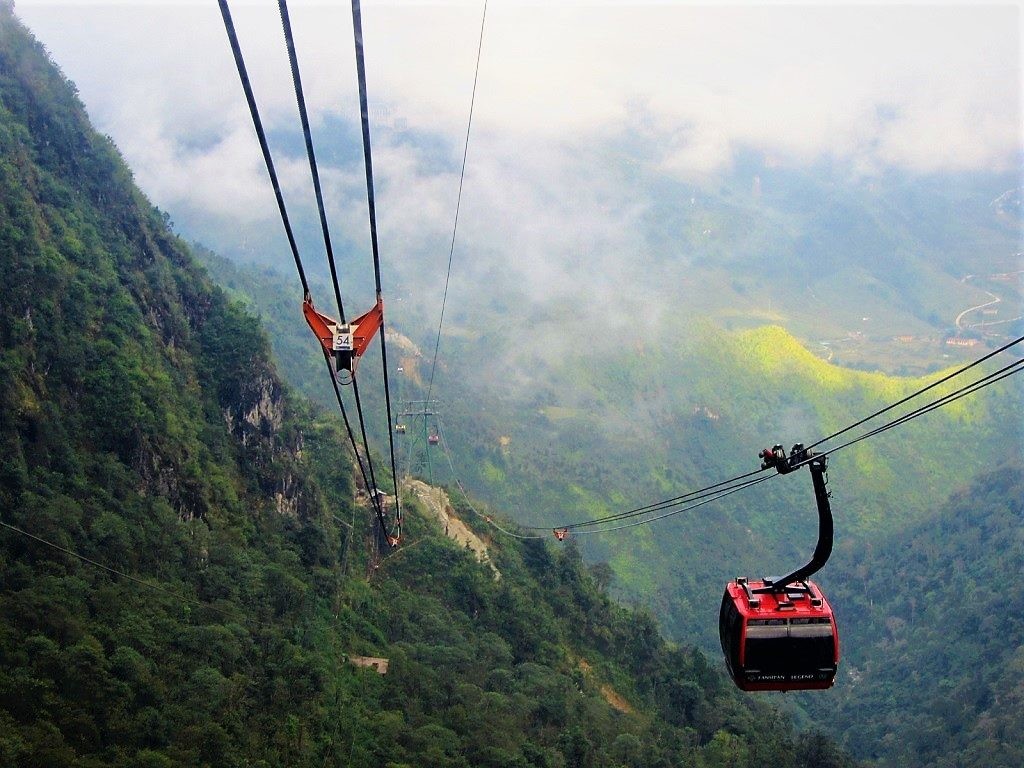 The Fansipan mountain summit cable car, Vietnam
The Fansipan mountain summit cable car, Vietnam
The cable car is a spectacular ride, passing high above the forested valley, in and out of the clouds, going from alpine forests near the top to terraced rice paddies near the bottom. The ride only takes about 15 minutes, even though it’s over 6km long and has an elevation gain of over 1,400m. It’s a smooth, beautiful ride, the cars are large, bright, comfortable and clean, and they operate constantly from 7am to 6pm. There’s even a train running from the cable car station at the bottom into Sapa town, or you can easily take a taxi. However, ticket prices for the cable car are high: 700,000vnd ($30) one-way for adults.
 The Fansipan mountain summit cable car, Vietnam
The Fansipan mountain summit cable car, Vietnam
Exploring the Spiritual and Architectural Wonders at Fansipan Summit
The summit of Fansipan, the highest peak in Indochina, isn’t just about breathtaking views and conquering a physical challenge. Today, it’s also home to a sprawling complex of spiritual and architectural wonders, attracting visitors seeking both adventure and cultural enrichment. Have you ever wondered about the structures that adorn this mountaintop? Let’s delve into the temples, statues, and other attractions that make the Fansipan summit a unique destination.
A Transformation at the Roof of Indochina
From Wilderness to Wonder:
Years ago, reaching the summit of Fansipan meant experiencing pristine wilderness. Now, a remarkable transformation has taken place, blending the natural allure of the mountain with impressive man-made structures. The opening of the cable car in 2016 marked a significant turning point, making the summit accessible to a wider audience and paving the way for the construction of a Buddhist temple complex and other attractions.
Spiritual Sanctuaries:
-
The Buddhist Temple Complex: This complex is a key highlight, featuring pagodas and temples designed with traditional Vietnamese architectural elements. The intricate designs and serene atmosphere offer a peaceful retreat amidst the clouds. The complex includes several structures, each with its own unique features and spiritual significance. The majestic pagodas, adorned with elaborate carvings and vibrant colors, stand as symbols of devotion and cultural heritage, attracting both pilgrims and tourists alike.
-
The Giant Seated Buddha: One of the most striking features is the enormous seated Buddha statue. Towering over the landscape, it creates a mesmerizing silhouette against the often misty backdrop, symbolizing peace and tranquility. The statue is visible from afar and serves as a focal point of the spiritual complex, drawing visitors to reflect and admire its grandeur. The cultural and spiritual significance of the site has evolved over time, blending traditional religious practices with modern tourism.
What Structures Are Located at The Fansipan Summit Complex?
Are you curious about what specific structures make up the Fansipan summit complex? The summit features a blend of cultural and commercial elements, all designed to enhance the visitor experience.
Key Features of the Fansipan Summit:
-
Pagodas and Temples: Explore intricately designed pagodas and temples, showcasing traditional Vietnamese architecture. These spiritual sites provide a serene atmosphere amidst the clouds, allowing for moments of reflection and appreciation of cultural heritage. The meticulous attention to detail in these structures reflects the deep spiritual roots of the region.
-
The Giant Seated Buddha: Marvel at the towering seated Buddha statue, a symbol of peace and tranquility. This iconic statue is visible from afar, creating a striking silhouette against the misty backdrop and serving as a focal point for visitors. Its presence enhances the spiritual ambiance of the summit.
-
Commercial Amenities: The summit also includes fast food stands, souvenir shops, and photography booths. These amenities cater to the diverse needs of visitors, providing convenient options for dining and shopping while enjoying the mountaintop experience.
-
Tourist Transportation Systems: Grand staircases, wooden decks, and plank walkways facilitate easy navigation around the summit. These infrastructure elements ensure that visitors can comfortably explore the various attractions and viewpoints, making the experience accessible to people of all ages and abilities.
-
Vietnamese Flags and Summit Pylons: Capture memorable photos with Vietnamese flags and summit pylons, symbols of national pride and achievement. These iconic landmarks offer a sense of accomplishment for those who reach the summit, marking their successful journey to the Roof of Indochina.
Visiting the Fansipan summit complex is a multi-faceted experience, combining spiritual exploration with modern conveniences. The blend of cultural landmarks and commercial amenities ensures that every visitor finds something to appreciate and enjoy.
The Impact of the Cable Car: Accessibility and Change
A Controversial Addition:
The cable car’s introduction has been met with mixed reactions. On one hand, it has made the summit accessible to a broader range of visitors, including the elderly and those with physical limitations. On the other hand, some argue that it has detracted from the mountain’s natural beauty and the sense of accomplishment that comes with a challenging climb.
Accessibility for All:
The cable car offers a swift and comfortable journey, whisking passengers from the base to the summit in just about 15 minutes. This ease of access has transformed Fansipan into a destination for Vietnamese families, including octogenarians and toddlers, who might otherwise never have experienced the Roof of Indochina.
A Different Kind of Pilgrimage:
For many Vietnamese, taking the cable car to the top of Fansipan is becoming a national pilgrimage. It’s an opportunity to stand at the highest point of their nation, take in the panoramic views (weather permitting), and connect with their country’s natural beauty.
What is the Significance of the Pagodas at Fansipan Summit?
The pagodas at the Fansipan summit are not just architectural marvels; they hold deep spiritual and cultural significance. These structures enhance the serene ambiance of the mountaintop, providing a place for reflection and reverence.
Historical and Cultural Roots:
-
Traditional Vietnamese Architecture: The pagodas are designed with traditional Vietnamese architectural elements, reflecting the country’s rich cultural heritage. Intricate carvings, vibrant colors, and meticulous attention to detail make these structures visually stunning and culturally significant. The architectural style is inspired by historical periods, creating a timeless appeal.
-
Spiritual Symbolism: Each pagoda serves as a spiritual sanctuary, inviting visitors to find peace and tranquility amidst the clouds. The placement and design of the pagodas are carefully considered to enhance the spiritual energy of the site. Statues of deities, incense offerings, and prayer wheels contribute to the sacred atmosphere.
-
Religious Practices: The pagodas are active sites of religious practice, where monks and devotees engage in prayer, meditation, and other rituals. Visitors are welcome to observe these practices respectfully, gaining insight into Vietnamese Buddhist traditions. The scent of incense, the sound of chanting, and the sight of saffron-robed monks create a unique and memorable experience.
The pagodas at Fansipan summit are more than just buildings; they are embodiments of Vietnamese culture and spirituality. Their presence enriches the visitor experience, offering a deeper connection to the country’s heritage.
The Experience of Reaching the Summit Today
A Mix of Emotions:
Arriving at the summit today can evoke a range of emotions. The juxtaposition of natural beauty and commercial development creates a unique and sometimes jarring experience. While some visitors may feel a sense of culture shock, others appreciate the convenience and accessibility that the new amenities provide.
Gratitude and Relief:
After a challenging climb, many hikers are grateful for the hot food and strong coffee available at the summit. The opportunity to wave a Vietnamese flag at the top and capture photos with the summit pylons adds a sense of accomplishment and national pride.
The Option to Descend by Cable Car:
For those who prefer not to hike down, the cable car offers a convenient and scenic descent. The ride provides stunning views of the surrounding landscape, allowing visitors to appreciate the beauty of the Hoang Lien Son Mountain Range from a different perspective.
How to Make the Most of Your Visit
Plan Ahead:
Before embarking on your Fansipan adventure, it’s essential to plan ahead. Check the weather forecast, pack appropriate clothing and gear, and book your transportation in advance. SIXT.VN can help you arrange reliable transportation from Sapa to the cable car station or trailhead.
Consider Your Fitness Level:
If you plan to hike to the summit, assess your fitness level and choose a trail that matches your abilities. The Tram Ton Pass trail is a popular option for independent hikers, but it still requires a reasonable level of physical fitness.
Embrace the Experience:
Whether you choose to hike or take the cable car, embrace the experience and appreciate the unique blend of natural beauty and cultural attractions that Fansipan has to offer. Take your time to explore the temple complex, admire the views, and soak in the serene atmosphere.
Respect the Environment:
Remember to respect the environment and follow Leave No Trace principles. Pack out all your trash, stay on marked trails, and avoid disturbing the natural vegetation. By being a responsible traveler, you can help preserve the beauty of Fansipan for future generations.
Capture Memories:
Don’t forget to bring your camera and capture the unforgettable moments of your Fansipan adventure. From the panoramic views at the summit to the intricate details of the temple complex, there are countless photo opportunities. Share your experiences with friends and family, inspiring them to explore this incredible destination.



